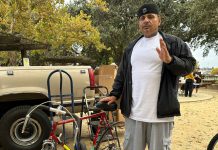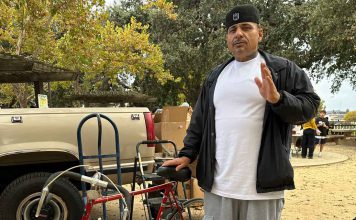When a Fresno mother-and-daughter duo’s idea for a hide-and-seek
doll made it onto the shelves of one of the nation’s largest toy
stores, they felt like they had won the lottery.
When a Fresno mother-and-daughter duo’s idea for a hide-and-seek doll made it onto the shelves of one of the nation’s largest toy stores, they felt like they had won the lottery.
Shelly Conte and her mother, Cindy Reichman, were riding high. Their patented Hide-N-Seek Hayley doll was being sold at Toys “R” Us stores nationwide, becoming a top seller during the 2005 holiday season.
“I remember someone telling us that we were going to be millionaires,” said Shelly Conte. “And I was thinking about it, no doubt.”
But Conte and Reichman’s dreams of fame and fortune began to unravel about a year later when a major player in the industry put a new spin on its popular Care Bear by introducing a hide-and-seek version. It soon edged out Hide-N-Seek Hayley, whose sales began to plummet.
Business experts say that in a fiercely competitive market for new products, copycats and timing all play a part in whether a new product stays on a store’s shelves or is relegated to the bargain bin. And to survive, they say, an entrepreneur must be market savvy, develop brand loyalty and “sleep with one eye open.”
“This can be a very tough business, and knockoff products are commonplace,” said Tim Walsh, a Florida-based toy inventor and author of “Timeless Toys,” a book that looks at classic toys and the people who created them. “The problem is that success often prompts others to want in on what you are doing.”
Walsh said a classic example is the Hula-Hoop. The name was trademarked in 1958 by Wham-O, but it didn’t stop others from cashing in on the plastic hoop’s popularity.
Walsh estimated that over the years Wham-O has kept only a quarter of the market.
Inventors say they never rest easy: The possibility of a much larger competitor taking them out is always a chief concern.
“I know I could wake up one day, and it could all be gone,” said Kathleen Whitehurst, co-inventor of DaysAgo, a digital day-counter that attaches to food containers and measures freshness of refrigerated products. “It is a cruel world out there, and that’s why you have to cover all your bases.”
Rookie inventors Reichman and Conte said their tumble from Toys “R” Us taught them many hard lessons, the most sobering is that patents don’t always protect you from copycats.
Shocked and frustrated by their abrupt sales slide, Conte and Reichman terminated their contract last year with Hayley’s manufacturer, the Kid-riffic toy company in St. Louis, which they fault for a lack of promotion.
Kid-riffic CEO Michael Roberts could not be reached to comment.
“We are almost in the exact same position we were eight years ago, when we started this idea,” Cindy Reichman said. “We should not be in this position. This was a once-in-a-lifetime chance for us and look at what’s happened.”
Reichman and Conte considered suing Play Along, the Florida-based Care Bear makers, but backed off after a lawyer specializing in such cases advised that they didn’t have a strong enough case. And even so, experts say, defending a patent can cost thousands of dollars in legal fees.
A spokeswoman for Play Along’s parent company, JAKKS Pacific, stood by the company’s decision to create the hide-and-seek Care Bear. Genna Rosenberg of JAKKS Pacific said the owners of Hide-N-Seek Hayley would only have a case for trademark infringement if Play Along gave its bear a similar name to the Hayley toy.
The daughter-mom inventor team’s patent attorney, Richard Ryan of Fresno, agreed, saying Play Along was careful not to copy the name “Hayley” or the specific technology used by the doll to play hide and seek.
Hayley, a soft 15-inch doll, comes with a hand-held radio device that offers clues to where she’s hiding. Depending on the distance, the walkie-talkie will tell a child whether he or she is getting closer or farther.
“Realistically, their competitor is doing it differently – and frankly not as unique as the Hayley doll,” Ryan said. “But it is not unfair competition, it is just competition.”
Mike Summers, director of technology development and commercialization at California State University, Fresno’s Lyles Center for Innovation and Entrepreneurship, said bringing an idea to the marketplace can be daunting for inventors who lack the experience and knowledge.
The center works with inventors to sift through their rough ideas and find the one that can be made and sold in the marketplace.
Summers said merely having a patent does not guarantee success.
“People think that once they get their patent, that it’s their ticket,” Summers said. “And while it may be a good idea, it may only be incrementally better than what is already out there” and could flop.
Summers, an inventor himself, developed a lifesaving device that inflates when hurled into water. But rather than compete head-to-head with much larger companies that also produce lifesaving devices, he approached the No. 2 player in the market. After some negotiation, that company agreed to buy his idea.
“Sometimes the collaborative route is the easier route to take,” Summers said. “It’s kind of like joining who you think your enemy is, but may indeed be your best friend.”
Reichman and Conte have made calls to toy companies and placed ads in industry magazines hoping to find a new manufacturer – all with no luck.
“They are probably not calling us back because they already know Care Bear is dominating the market,” Conte said. “And why should they buy our doll when they can go around it?”
Although Hide-N-Seek Hayley didn’t make millions as Conte and Reichman dreamed of, it did bring in about $100,000, which the pair split and used to pay bills. Conte also bought a couch and a washer and dryer.
Still, the pair is not giving up. They want Hayley and a companion toy, a hide-and-seek dog named Sammie, on store shelves and they’re also hoping to enlist the help of Congress, the general public, even Oprah Winfrey, to push for tougher protections for small inventors and against copycats.
“Bigger toy companies have taken away our dream,” Conte said. “This was our dream, not their dream.”













